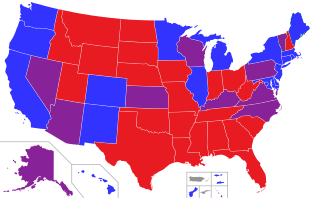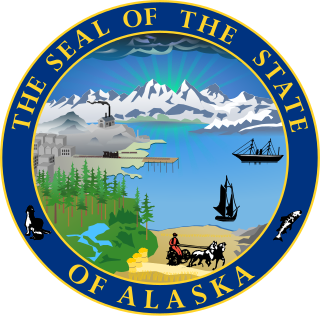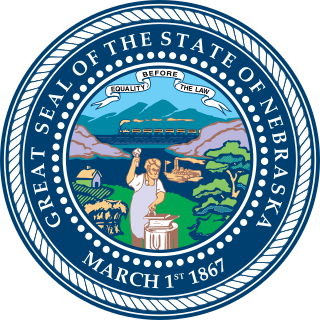{{Infobox legislature
| background_color = #E81B23 | name = Alaska State Senate | legislature = Alaska Legislature | coa_pic = Seal of the State of Alaska.svg | house_type = Upper house | term_limits = None | session_room = Senate Chamber, Alaska.jpg | new_session = January 17, 2023 | leader1_type = President | leader1 = Gary Stevens (R-C) | election1 = January 17, 2023 | leader2_type = Majority Leader | leader2 = Cathy Giessel (R-C) | election2 = January 17, 2023 | leader3_type = Minority Leader | leader3 = Shelley Hughes ([[Republican Party (United States) [R]]-Non Coalition government/NC) | election3 = January 17, 2023 | structure1 = Alaska State Senate 2023-2025.svg | structure1_res = 250px | term_length = 4 years | authority = Article 2, Alaska Constitution | salary = $50,400/year + per diem ($200/day, in session) | members = 20 | voting_system1 = Nonpartisan blanket primary / Ranked-choice voting
(Beginning in 2022) | last_election1 = November 8, 2022 (19 seats: all except district T) | next_election1 = November 5, 2024 (10 seats: districts B, D, F, H, J, L, N, P, R, T) | redistricting = Alaska Redistricting Board | political_groups1 =
Majority coalition
Non-caucusing members
| meeting_place = State Senate Chamber
Alaska State Capitol
Juneau, Alaska | website = Alaska State Senate
}} The Alaska State Senate is the upper house in the Alaska Legislature, the state legislature of the U.S. state of Alaska. It convenes in the Alaska State Capitol in Juneau, Alaska and is responsible for making laws and confirming or rejecting gubernatorial appointments to the state cabinet, commissions and boards.
With just twenty members, the Alaska Senate is the smallest state legislative chamber in the United States. Its members serve four-year terms and each represent an equal number of districts with populations of approximately 35,512 people, per 2010 census figures. They are not subject to term limits.
The Alaska Senate shares the responsibility for making laws in the state of Alaska with the Alaska House of Representatives. Bills are developed by staff from bill requests and information from the bill's sponsor. Bills undergo three or four readings during the legislative process. After the first reading, they are assigned to committee. Committees can amend measures or hold legislation and prevent it from reaching the Senate floor. Once a committee has weighed in on a piece of legislation, the bill returns to the floor for second hearing and a third hearing, which happens just before the floor vote on it. [1]
Once passed by the Senate, a bill is sent to the opposite legislative house for consideration. If approved, without amendment, it is sent to the governor. If there is amendment, however, the Senate may either reconsider the bill with amendments or ask for the establishment of a conference committee to work out differences in the versions of the bill passed by each chamber. Once a piece of legislation approved by both houses is forwarded to the governor, it may either be signed or vetoed. If it is signed, it takes effect on the effective date of the legislation. If it is vetoed, lawmakers in a joint session may override the veto with a two-thirds majority vote (three-fourths majority is required if it is an appropriations bill). [1]
For gubernatorial nominees requiring confirmation, the Alaska Senate sits in joint session with the Alaska House and the two bodies vote together on confirmation, with each representative and senator having one vote.
Current committees include: [2]
| Affiliation | Party (Shading indicates majority caucus) | Total | ||||
|---|---|---|---|---|---|---|
| Democratic | Republican | Vacant | ||||
| End 29th legislature | 5 | 1 | 14 | 20 | 0 | |
| 30th legislature | 5 | 1 | 14 | 20 | 0 | |
| 31st Legislature | 6 | 1 | 13 | 20 | 0 | |
| 32nd Legislature | 6 | 1 | 13 | 20 | 0 | |
| Begin 33rd Legislature | 9 | 8 | 3 | 20 | 0 | |
| Latest voting share | 85% | 15% | ||||
Past partisan compositions can be found on Political party strength in Alaska.
Senators must be a qualified voter and resident of Alaska for no less than three years, and a resident of the district from which elected for one year immediately preceding filing for office. [3] A senator must be at least 25 years old at the time the oath of office is taken. [3]
Senators may expel a member with the concurrence of two-thirds of the membership of the body. [3] This has happened only once in Senate history. On February 5, 1982, the Senate of the 12th Legislature expelled Bethel senator George Hohman from the body. Hohman was convicted of bribery in conjunction with his legislative duties on December 24, 1981, and had defiantly refused to resign from his seat. Expulsion was not a consideration during the 2003–2010 Alaska political corruption probe, as Ben Stevens and John Cowdery were the only Senators who were subjects of the probe and neither sought reelection in 2008.
Legislative terms begin on the second Monday in January following a presidential election year and on the third Tuesday in January following a gubernatorial election. [4] The term of senators is four years and half of the senators are up for election every two years. [4]
The President of the Senate presides over the body, appointing members to all of the Senate's committees and joint committees, and may create other committees and subcommittees if desired. Unlike many other states, the Lieutenant Governor of Alaska does not preside over the Senate. Instead, the Lieutenant Governor oversees the Alaska Division of Elections, fulfilling the role of Secretary of State. Only two other states, Hawaii and Utah, have similar constitutional arrangements for their lieutenant governors.[ citation needed ] The other partisan Senate leadership positions, such as the Majority and Minority leaders, are (usually) elected by their respective party caucuses to head their parties in the chamber.[ citation needed ]
| Position | Name | Party | District |
|---|---|---|---|
| President | Gary Stevens | Republican | C |
| Majority Leader | Cathy Giessel | Republican | E |
| Minority Leader | Shelley Hughes | Republican | M |
| District | Name | Party | Residence | Assumed office | Next election |
|---|---|---|---|---|---|
| A | Bert Stedman | Republican | Sitka | 2003 [lower-alpha 1] | 2026 |
| B | Jesse Kiehl | Democratic | Juneau | 2019 | 2024 |
| C | Gary Stevens | Republican | Kodiak | 2003 [lower-alpha 1] | 2026 |
| D | Jesse Bjorkman | Republican | Anchorage | 2023 | 2024 |
| E | Cathy Giessel | Republican | Anchorage | 2023 (2011–2021) | 2026 |
| F | James Kaufman | Republican | Anchorage | 2023 | 2024 |
| G | Elvi Gray-Jackson | Democratic | Anchorage | 2019 | 2026 |
| H | Matt Claman | Democratic | Anchorage | 2023 | 2024 |
| I | Löki Tobin | Democratic | Anchorage | 2023 | 2026 |
| J | Forrest Dunbar | Democratic | Anchorage | 2023 | 2024 |
| K | Bill Wielechowski | Democratic | Anchorage | 2007 | 2026 |
| L | Kelly Merrick | Republican | Eagle River | 2023 | 2024 |
| M | Shelley Hughes | Republican [lower-alpha 2] | Palmer | 2017 | 2026 |
| N | David Wilson | Republican | Wasilla | 2017 | 2024 |
| O | Mike Shower | Republican [lower-alpha 2] | Wasilla | 2018 [lower-alpha 1] | 2026 |
| P | Scott Kawasaki | Democratic | Fairbanks | 2019 | 2024 |
| Q | Robert Myers | Republican [lower-alpha 2] | North Pole | 2021 | 2026 |
| R | Click Bishop | Republican | Fairbanks | 2013 | 2024 |
| S | Lyman Hoffman | Democratic | Bethel | 1995 | 2026 |
| T | Donny Olson | Democratic | Golovin | 2001 | 2024 |

In the United States, the state legislature is the legislative branch in each of the 50 U.S. states.

The Maine Legislature is the state legislature of the U.S. state of Maine. It is a bicameral body composed of the lower house Maine House of Representatives and the upper house Maine Senate. The Legislature convenes at the State House in Augusta, where it has met since 1832.

The Michigan Legislature is the legislature of the U.S. state of Michigan. It is organized as a bicameral body composed of an upper chamber, the Senate, and a lower chamber, the House of Representatives. Article IV of the Michigan Constitution, adopted in 1963, defines the role of the Legislature and how it is to be constituted. The chief purposes of the Legislature are to enact new laws and amend or repeal existing laws. The Legislature meets in the Capitol building in Lansing.

The Alaska Legislature is the state legislature of the U.S. state of Alaska. It is a bicameral institution consisting of the 40-member Alaska House of Representatives and the 20-member Alaska Senate. There are 40 House Districts (1–40) and 20 Senate Districts (A–T). With a total of 60 lawmakers, the Alaska Legislature is the smallest bicameral state legislature in the United States and the second-smallest of all state legislatures. There are no term limits for either chamber. The Alaska Legislature meets in the Alaska State Capitol in Juneau. The current meeting since 2023 is the 33rd Alaska State Legislature. The previous meeting, the 32nd Alaska State Legislature, met from 2021 to 2023.

The Maryland General Assembly is the state legislature of the U.S. state of Maryland that convenes within the State House in Annapolis. It is a bicameral body: the upper chamber, the Maryland Senate, has 47 representatives, and the lower chamber, the Maryland House of Delegates, has 141 representatives. Members of both houses serve four-year terms. Each house elects its own officers, judges the qualifications and election of its own members, establishes rules for the conduct of its business, and may punish or expel its own members.

The Florida Legislature is the legislature of the U.S. state of Florida. It is organized as a bicameral body composed of an upper chamber, the Senate, and a lower chamber, the House of Representatives. Article III, Section 1 of the Florida Constitution, adopted in 1968, defines the role of the legislature and how it is to be constituted. The legislature is composed of 160 state legislators. The primary purpose of the legislature is to enact new laws and amend or repeal existing laws. It meets in the Florida State Capitol building in Tallahassee.

The Colorado State Senate is the upper house of the Colorado General Assembly, the state legislature of the US state of Colorado. It is composed of 35 members elected from single-member districts, with each district having a population of about 123,000 as of the 2000 census. Senators are elected to four-year terms, and are limited to two consecutive terms in office. Senators who are term-limited become eligible to run again after a one-term respite.

The Michigan Senate is the upper house of the Michigan Legislature. Along with the Michigan House of Representatives, it composes the state legislature, which has powers, roles and duties defined by Article IV of the Michigan Constitution, adopted in 1963. The primary purpose of the Legislature is to enact new laws and amend or repeal existing laws.

The Tennessee General Assembly (TNGA) is the state legislature of the U.S. state of Tennessee. It is a part-time bicameral legislature consisting of a Senate and a House of Representatives. The Speaker of the Senate carries the additional title and office of Lieutenant Governor of Tennessee. In addition to passing a budget for state government plus other legislation, the General Assembly appoints three state officers specified by the state constitution. It is also the initiating body in any process to amend the state's constitution.

The Mississippi Senate is the upper house of the Mississippi Legislature, the state legislature of the U.S. state of Mississippi. The Senate, along with the lower Mississippi House of Representatives, convenes at the Mississippi State Capitol in Jackson.

The Alaska State House of Representatives is the lower house in the Alaska Legislature, the state legislature of the U.S. state of Alaska. The House is composed of 40 members, each of whom represents a district of approximately 17,756 people per 2010 census figures. Members serve two-year terms without term limits. With 40 representatives, the Alaska House is the smallest state legislative lower chamber in the United States. The House convenes at the State Capitol in Juneau.

The Maryland Senate, sometimes referred to as the Maryland State Senate, is the upper house of the General Assembly, the state legislature of the U.S. state of Maryland. Composed of 47 senators elected from an equal number of constituent single-member districts, the Senate is responsible, along with the Maryland House of Delegates, for passage of laws in Maryland, and for confirming executive appointments made by the Governor of Maryland.

The Mississippi Legislature is the state legislature of the U.S. state of Mississippi. The bicameral Legislature is composed of the lower Mississippi House of Representatives, with 122 members, and the upper Mississippi State Senate, with 52 members. Both representatives and senators serve four-year terms without term limits. The Legislature convenes at the Mississippi State Capitol in Jackson.

The Arizona State Legislature is the state legislature of the U.S. state of Arizona. It is a bicameral legislature that consists of a lower house, the House of Representatives, and an upper house, the Senate. Composed of 90 legislators, the state legislature meets in the Capitol Complex in the state capital of Phoenix. Created by the Arizona Constitution upon statehood in 1912, the Arizona State Legislature met biennially until 1950. Today, they meet annually.

The Florida Senate is the upper house of the Florida Legislature, the state legislature of the U.S. state of Florida, the Florida House of Representatives being the lower house. Article III, Section 1 of the Constitution of Florida, adopted in 1968, defines the role of the Legislature and how it is to be constituted. The Senate is composed of 40 members, each elected from a single-member district with a population of approximately 540,000 residents. Legislative districts are drawn on the basis of population figures, provided by the federal decennial census. Senators' terms begin immediately upon their election. The Senate Chamber is located in the State Capitol building.

The government of Alabama is organized under the provisions of the 2022 Constitution of Alabama. Like other states within the United States, Alabama's government is divided into executive, judicial, and legislative branches. Also like any other state, these three branches serve a specific purpose in terms of power.

The Alabama Legislature is the legislative branch of the government of the U.S. state of Alabama. It is a bicameral body composed of the House of Representatives and Senate. It is one of the few state legislatures in which members of both chambers serve four-year terms and in which all are elected in the same cycle. The most recent election was on November 8, 2022. The new legislature assumes office immediately following the certification of the election results by the Alabama Secretary of State which occurs within a few days following the election.

The Legislature of the State of Oklahoma is the state legislative branch of the U.S. state of Oklahoma. The Oklahoma House of Representatives and Oklahoma Senate are the two houses that make up the bicameral state legislature. There are 101 state representatives, each serving a two-year term, and 48 state senators, who serve four-year terms that are staggered so only half of the Oklahoma Senate districts are eligible in each election cycle. Legislators are elected directly by the people from single member districts of equal population. The Oklahoma Legislature meets annually in the Oklahoma State Capitol in Oklahoma City.

The Kansas Senate is the upper house of the Kansas Legislature, the state legislature of the U.S. State of Kansas. It is composed of 40 senators elected from single-member districts, each with a population of about 73,000 inhabitants. Members of the Senate are elected to a four-year term. There is no limit to the number of terms that a senator may serve. The Kansas Senate meets at the Kansas State Capitol in Topeka.

The Nebraska Legislature is the legislature of the U.S. state of Nebraska. The Legislature meets at the Nebraska State Capitol in Lincoln. With 49 members, known as "senators", the Nebraska Legislature is the smallest U.S. state legislature. A total of 25 members is required for a majority; however, in order to overcome a filibuster, a two-thirds vote of all members is required, which takes 33 votes.